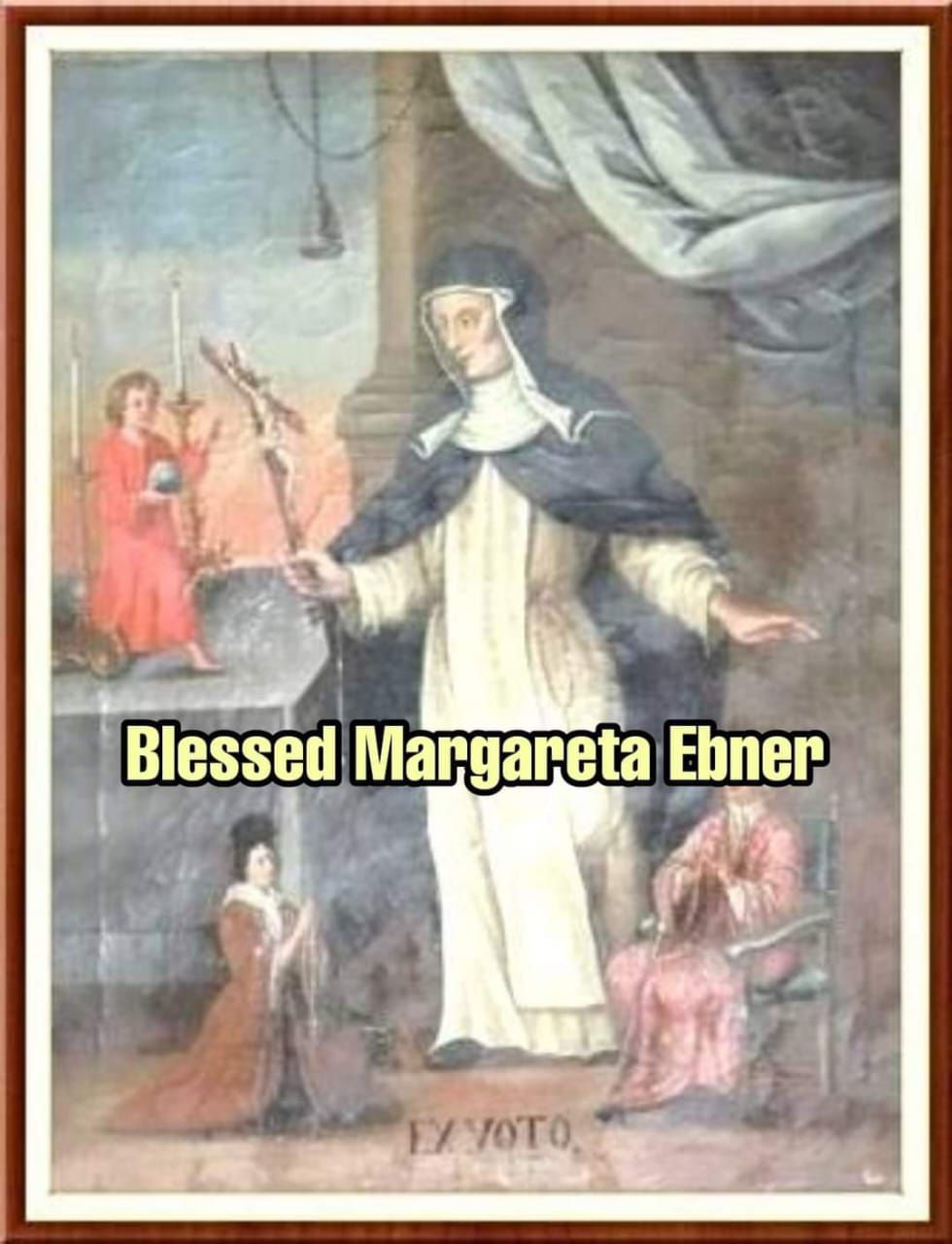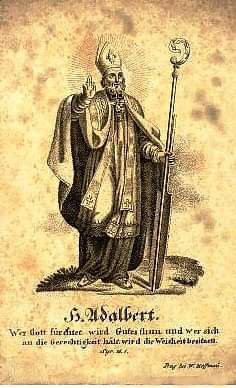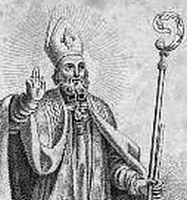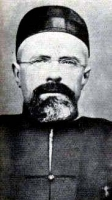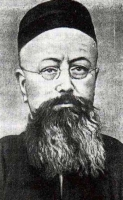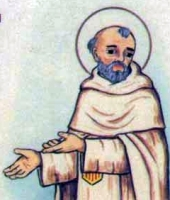St. Florentina
Born Cartagena, Hispania
Died ca. 612
Venerated in Catholic Church
Eastern Orthodox Church
Canonized Pre-Congregation
Feast 20 June
Spanish abbess. She was born in Cartagena, Spain, and was the sister of Sts. Leander, Isidore, and Fulgentius. Leander raised Florentina and founded a convent for her, where she became abbess.
Florentina of Cartagena (died ca. 612) is venerated as a saint by the Catholic Church. Born towards the middle of the sixth century in Cartagena, Hispania,[1] she and her family were actively engaged in furthering the best interests of Christianity.
Florentina was the sister of three Iberian bishops in the time of the Visigothic dominion (Leander, Isidore of Seville, and Fulgentius). She was younger than her brother Leander, later Archbishop of Seville, but older than Isidore, who succeeded Leander as archbishop of the same see. All four have been canonized by the Catholic Church.[2]
Losing their parents at an early age, she was placed under the guardianship of her brother, Leander, who had since taken monastic vows, and it was through his influence that Florentina embraced the ascetic life.[3] She associated with herself a number of virgins, who also desired to forsake the world, and formed them into a religious community. Later sources declare their residence to have been the convent of S. Maria de Valle near Ecija (Astigis), of which city her brother Fulgentius was bishop.[4] She later became abbess of the community.
Sometime before the year 600, her brother Leander, who died either in the year 600 or 601, wrote for her guidance an extant work dealing with a nun's rule of life and with contempt for the world. In it the author lays down the rules according to which cloistered consecrated virgins should regulate their lives. He strongly advises them to avoid interaction with women living in the world, and with men, especially youths; recommends strict temperance in eating and drinking, gives advice concerning the reading of and meditation on Holy Scripture, enjoins equal love and friendship for all those living together in community, and exhorts his sister earnestly to remain true to her holy state.[4]
Florentina regulated her life according to the advice of her brother, entered with fervour into the spirit of the religious life, and was honoured as a saint after her death. She died sometime early in the seventh century.[4]
Veneration
Florentina is venerated as the patroness of the diocese of Plasencia.[3] Her feast falls on 20 June. The name is written Florentia in the Roman martyrology, but Florentina is without doubt the correct form.
An part of her bones were buried in the cathedral of Murcia (Spain), where they continue to be venerated. However, most of her remains are preserved in Berzocana (Spain), where she is venerated as well as her brother Fulgentius.
St. Silverius
Church Catholic Church
Papacy began 8 June 536
Papacy ended March 537
Predecessor Agapetus I
Successor Vigilius
Personal details
Born Campania, Italy
Died 2 December 537
Palmarola, Kingdom of the Ostrogoths
Sainthood
Feast day 20 June
Patronage Island of Ponza
The son of Hormisdas, St. Silverius was nominated to succeed Agapetus I in 536 by King Theodahad of the Goths and was elected through his influence. Empress Theodora had wanted a pope more open to monothelitism and sent Belisarius to depose Silverius. Accused of conspiring with the Goths, Silverius was made a monk and exiled to Patara in early 537. When Silverius appealed his case to Justinian, he was allowed to return to Rome. Vigilius, who had become pope through Theodora's influence, sent Silverius to the island of Palmaria, where he was persuaded to abdicate. Silverius died shortly thereafter. He may have starved, or he may have been murdered.
Pope Silverius (died 2 December 537) was bishop of Rome from 8 June 536 to his deposition in 537, a few months before his death. His rapid rise to prominence from a deacon to the papacy coincided with the efforts of Ostrogothic king Theodahad (nephew to Theodoric the Great), who intended to install a pro-Gothic candidate just before the Gothic War. Later deposed by Byzantine general Belisarius, he was tried and sent to exile on the desolated island of Palmarola, where he starved to death in 537.
Life
He was a legitimate son of Pope Hormisdas, born in Frosinone, Lazio, some time before his father entered the priesthood. Silverius was probably consecrated 8 June 536. He was a subdeacon when king Theodahad of the Ostrogoths forced his election and consecration. Historian Jeffrey Richards interprets his low rank prior to becoming pope as an indication that Theodahad was eager to put a pro-Gothic candidate on the throne on the eve of the Gothic War and "had passed over the entire diaconate as untrustworthy".[1] The Liber Pontificalis alleges that Silverius had purchased his elevation from King Theodahad.[2]
On 9 December 536, the Byzantine general Belisarius entered Rome with the approval of Pope Silverius. Theodahad's successor Witiges gathered together an army and besieged Rome for several months, subjecting the city to privation and starvation. In the words of Richards, "What followed is as tangled a web of treachery and double-dealing as can be found anywhere in the papal annals. Several different versions of the course of events following the elevation of Silverius exist."[3] In outline, all accounts agree: Silverius was deposed by Belisarius in March 537 and sent into exile after being judged by the wife of Belisarius, Antonina, who accused him of conspiring with the Goths.[4] Not only did Belisarius exile Silverius, he also banished a number of distinguished senators, Flavius Maximus—a descendant of a previous emperor—among them.[5] Vigilius, who was in Constantinople as apocrisiarius or papal legate, was brought to Rome to replace Silverius as the pontiff.[6]
The fullest account is in the Breviarium of Liberatus of Carthage, who portrays Vigilius "as a greedy and treacherous pro-Monophysite who ousted and virtually murdered his predecessor." In exchange for being made Pope, Liberatus claims he promised Empress Theodora to restore the former patriarch of Constantinople, Anthimus, to his position. Silverius was sent into exile at Patara in Lycia, whose bishop petitioned the emperor for a fair trial for Silverius. Rattled by this, Justinian ordered Silverius returned to Rome to be tried accordingly.[7] However, when Silverius returned to Italy, instead of holding a trial Belisarius handed him over to Vigilius, who according to The Liber Pontificalis banished Silverius to the desolate island Palmarola (part of the Pontine Islands), where he starved to death a few months later.[8]
The account in the Liber Pontificalis is hardly more favorable to Vigilius. That work agrees with Liberatus that the restoration of Anthimus to the Patriarchate was the cause of Silverius' deposition, but Vigilius was initially sent to persuade Silverius to agree to this, not replace him. Silverius refused and Vigilius then claimed to Belisarius that Pope Silverius had written to Witiges offering to betray the city. Belisarius did not believe this accusation, but Vigilius produced false witnesses to testify to this, and through persistence overcame his scruples. Silverius was summoned to the Pincian palace, where he was stripped of his vestments and handed over to Vigilius, who dispatched him into exile. Procopius omits all mention of religious controversy in Vigilius' actions. He writes that Silverius was accused of offering to betray Rome to the Goths. Upon learning of this, Belisarius had him deposed, put in a monk's habit and exiled to Greece. Several other senators were also banished from Rome at the same time on similar charges. Belisarius then appointed Vigilius.[9] Deprived of sufficient sustenance, Silverius starved to death on the island of Palmarola.[10]
Richards attempts to reconcile these divergent accounts into a unified account. He points out that Liberatus wrote his Breviarium at the height of the Three-Chapter Controversy, "when Vigilius was being regarded by his opponents as anti-Christ and Liberatus was prominent among these opponents", and the Liber Pontificalis drew from an account written at the same time. Once these religious elements are removed, Richards argues that it is clear "the whole episode was political in nature."[8] He points out for Justinian's plans to recover Rome and Italy, "that there should be a pro-Eastern pope substituted as soon as possible. The ideal candidate was at hand in Constantinople. The deacon Vigilius' principal motivation throughout his career, as far as can be ascertained, was the desire to be pope and he was not really concerned about which faction put him there."[8]
Canonization
Feast day of Saint Silverius, Ponza. June 20, 2008.
Silverius was later recognized as a saint by popular acclamation, and is now the patron saint of the island of Ponza, Italy. According to Ponza Islands legend, fishermen were in a small boat in a storm off Palmarola and they called on Saint Silverius for help. An apparition of Saint Silverius called them to Palmarola, where they survived. This miracle made him venerated as a saint. The first mention of his name in a list of saints dates to the 11th century.[11] He is also called Saint Silverius (San Silverio). While Pope Silverius perished without fanfare and largely unlamented during the 6th century, the people from the neighboring island of Ponza have honored the virtuous St. Silverio, a heritage that reaches from the island to the United States, where many settlers from the island have settled in the Morrisania section of the Bronx. From there, they celebrated the Festival of San Silverio at Our Lady of Pity Church on 151st Street and Morris Avenue, just as they had for centuries, calling on him for help.[12]
In 1987, the San Silverio Committee of Morris Park Inc. was founded, allowing those of Ponzese descent and those devoted to San Silverio to celebrate the feast closer to their home. Offering yearly novenas, and a traditional feast on June 20, devotees gather in Saint Clare of Assisi Church for a mass, followed by a procession throughout the neighborhood. The San Silverio Committee of Morris Park have offered their talents to the parish of Saint Clare's for many years, designing and building a 30-foot Neapolitan crèche at Christmas, and erecting a tomb for the Easter season.
Adding to the feast of San Silverio, the committee honors Saint Anthony and the Immaculate Conception with novenas, mass and procession. The neighborhood has seen changes in recent years but is still populated with Italian restaurants and food stores, where the festival continues to unify the community. After the Church of Our Lady of Pity was deconsecrated in November 2017,[13] the statue of San Silverio found a home at St. Ann's Church at 31 College Place, Yonkers, New York. The feast of San Silverio is observed there every year on June 20 with a special Mass and procession of the Statue of San Silverio. The statue is on permanent display for veneration by the faithful.
St. Julius and Aaron
Died c. 304 AD
Caerleon, Britain, Roman Empire
Honoured in Roman Catholic Church
Anglican Communion
Feast 1 July (trad.[1])
22 June (Cath.[2])
20 June (Cath.[3] and Ang.[4])
Martyrs of Britain, put to death at Caerlon, Monmouthshire, with companions. St. Bede listed them in his martyrology.
Julius and Aaron (also Julian) were two Romano-British Christian saints who were martyred around the third century. Along with Saint Alban, they are the only named Christian martyrs from Roman Britain. Most historians place the martyrdom in Caerleon, although other suggestions have placed it in Chester or Leicester. Their feast day was traditionally celebrated on 1 July,[1] but it is now observed together with Alban on 20 June by the Roman Catholic and Anglican Churches.[3][4]
The earliest surviving account of Julius and Aaron comes from Gildas, a monk writing in Western Britain during the sixth century. How accurate his account of events that occurred three centuries before is remains unknown. Gildas' account was later repeated by the eighth-century Anglo-Saxon monk Bede. References to Julius and Aaron were included in the work of later medieval authors like Geoffrey of Monmouth and Giraldus Cambrensis.
Gildas implied that a martyrium dedicated to Julius and Aaron was present by the sixth century, and a chapel dedicated to the saints certainly in existence near Caerleon by the ninth century, when it was recorded in a land charter. In the early twelfth century, the church passed into the property of the new Goldcliff Priory, and by 1142 had been renamed in dedication to St Alban as well as Julius and Aaron, reflecting the growing popularity of the former's cult. In later centuries, the chapel's associations with Julius and Aaron were forgotten. By the time of the sixteenth-century English Reformation, when the chapel was abandoned and perhaps converted into a barn, it was solely referred to as a Church of Saint Alban. The building fell into dilapidation and no longer survives.
Martyrdom
The Romano-British amphitheatre in Caerleon, the settlement where Julius and Aaron were reportedly martyred
Julius and Aaron are two of the three Christian martyrs recorded as having lived in Roman Britain, the other being St Alban.[5] Nothing is known of them except for their martyrdom.[6] The name "Aaron" is Hebrew and might suggest an individual of Jewish heritage.[7] The name was exceptionally rare in both Jewish and Christian contexts at that time.[8] The name "Julius" was extremely common among the soldiers at Caerleon, reflecting either descent from one of the Julio-Claudian Coloniae or a name taken on enlistment in the army.[8] Although Caerleon was a major military base in western Britain, there was a civilian settlement association with the fort, and thus Julius and Aaron could have been civilians rather than soldiers.[9]
Date of martyrdom
The Roman military fort at Caerleon held the Legio II Augusta, and witnessed much usage under the Roman Emperors Septimius Severus and Caracalla although saw a reduction in its occupation during the third century, when much of the legion was stationed elsewhere.[10] The fort fell out of use between circa 287 and 296, when many of its buildings were demolished.[11] The core of the legion were reassigned to the Richborough Fort in modern Kent.[12] Given the abandonment of the fort at the end of the third century, it is unlikely that Julius and Aaron would have been killed as part of the anti-Christian persecutions which took place in the early fourth century.[9]
It is more probable that they might have been executed during one of the phases of anti-Christian agitation which broke out in the empire during the mid-third century, particularly between 249 and 251 under Emperor Decius and then between 257 and 259 under Valerian.[9] More broadly, Jeremy K. Knight noted that it probably took place at some point between Septimius Severus' prohibition on anyone converting to Christianity and Aurelian's death in 275, for his successor Constantius Chlorus did not reportedly execute Christians but restricted himself to the demolition of their churches
Blessed Margareta Ebner
புனித.மர்கரீத் எப்னர்(St.Margarete Ebner)
பிறப்பு
1291
டோனவ்வோர்த்(Donauworth), அவுக்ஸ்பூர்க்(Augsburg)
இறப்பு
20 ஜூன் 1351
தில்லிங்கன் என்ற ஊரில் இவருக்கென்று ஓர் ஆலயம் உள்ளது. அங்குதான் இவர்தான் இறுதி நாட்களை கழித்துள்ளார். பலவித கலாசாரத்தை கொண்ட மக்களிடத்தில் இவர் பணியாற்றினார். இவர் தனது 15 ஆம் வயதில் புனித டொமினிக்கன் சபையில் சேர்ந்து துறவியானார். அவர் அச்சபையில் வாழ்ந்தபோது 1312 ஆம் ஆண்டிலிருந்து தொடர்ந்து 14 ஆண்டுகள் ஆண்டவரின் காட்சிகளை பலமுறை கண்டார். இவர் மிகவும் கடுமையான நோயால் தாக்கப்பட்டு, படுக்கையிலேயே தன் வாழ்நாட்களை கழித்தார். நோயால் மிகவும் வேதனைக்குள்ளானார். இதனால் இறைவனின்மீது தன் முழு நம்பிக்கையையும் வைத்து, இடைவிடாது செபித்தார். ஆண்டவரின் பாடுகளில் அவ்வப்போது பங்கெடுத்தார். இவரின் ஆன்ம வழிகாட்டி தந்தை ஹென்றி அவர்களின் அறிவுரைப்படி, தொடர்ந்து ஆண்டவரின் பாடுகளில் பங்கெடுத்தார். ஒருநாள் ஆண்டவர் கொடுத்த காட்சியை கண்டுகொண்டிருக்கும்போதே, தன் கண்களை மூடியபடியே உயிர் நீத்தார்.
இவர் இறந்தபிறகு இவரின் கல்லறையை எண்ணிலடங்கா மக்கள் சந்திக்க வந்தனர். அங்கு வந்த அத்தனை பேருக்கும் ஏதாவது ஒரு வகையில் புதுமைகளை செய்தார். இவர் இறந்த சில ஆண்டுகள் கழித்து அவரின் கல்லறைமேல் இயேசு கிறிஸ்துவின் உருவம் கொண்ட ஒரு சுரூபம் தானாகவே வளர்ந்தது. 1751 ல் சாதாரணமாக இருந்த இவரின் கல்லறைமேல் 1751-1755 வரை ஓர் ஆலயம் கட்டப்பட்டு, இன்றும் அவ்வாலயத்தில் அவரின் பெயரால் வழிபாடுகள் நடக்கின்றது.
செபம்:
குணமளிப்பவரே எம் தந்தையே இறைவா! இவ்வுலகில் நோயினால் வாடும் மக்களை நீர் கண்ணோக்கியருளும். தங்களின் நோய்களை தாங்கும் உடல் பலத்தையும், மனபலத்தையும் தந்து, வாழ்வில் மீண்டும் புத்துயிர் பெற்று வாழ நீர் வரம் தந்து வாழ்வை அளிக்குமாறு இறைவா உம்மை மன்றாடுகின்றோம்.
Also known as
• Margaret, Margaretha, Margrete
• Mystic of Mödingen
Profile
Born wealthy. Received a thorough classical education at home. Dominican nun at Maria-Medingen, Germany convent in 1306. Dangerously ill from 1312 to 1322 during which time she was sent home to recover, and during which she began receiving visions, revelations and prophies. Visited by the Infant Christ. Spiritual student of Father Henry of Nördlingen from 1332 to her death. Their correspondence is the first collection of its kind in German. At his command she wrote a full account of her mystic experiences.
Born
c.1291 at Donauwörth, Bavaria, Germany
Died
20 July 1351 at Mödingen, Bavaria, Germany of natural causes
Beatified
• 24 February 1979 by Pope John Paul II (cultus confirmation)
• the first beatification of John Paul's pontificate
Reading
O God, source of all goodness, you enkindled within Blessed Margaret the fire of the Holy Spirit and drew her into the secrets of your divine love. By the help of her prayers and filled with that same Spirit may we come to you by the paths of Christ, who lives and reigns with you and the Holy Spirit, one God, for ever and ever. - General Calendar of the Order of Preachers
Blessed Dermot O'Hurley
Also known as
• Dermit
• Diarmaid Ó Hiarlatha
Profile
Born to a wealthy family, the son of William O'Brien O'Hurley and Honoria. Studied at the University of Leuven, Belgium where he obtained his law degree. Dean of the law school at Leuven for 15 years. Taught in Rheims, France for 4 years. Chosen archbishop of Cashel, Ireland by Pope Gregory XIII in 1581 while Dermot was still a layman; he received the pallium on 27 November of that year.
He returned to Ireland in secret and kept on the move as Protestant authorities were watching for him. However, to save one of his hosts from trouble with the authorities, he surrendered when they caught up with him. Imprisoned, tortured and executed in the persecutions of Elizabeth I for the treason of refusing to acknowledge her as head of the Church. One of the Irish Martyrs.
Born
c.1530 in Emly, County Tipperary, Ireland
Died
• hanged on 20 June 1584 at Hoggen Green, (modern College Green) Dublin, Ireland
• buried at the church of Saint Kevin in Dublin
Beatified
27 September 1992 by Pope John Paul II in Rome, Italy
Saint Adalbert of Magdeburg
மக்டேபர்க் புனிதர் அடால்பர்ட்
மக்டேபர்க் பேராயர்/ விஸ்செம்பௌர்க் மடாதிபதி:
பிறப்பு: கி.பி. 910
அல்சாஸ் அல்லது லோர்ரெய்ன், ஃபிரான்ஸ்
இறப்பு: ஜூன் 20, 981
ஸ்செர்பேன், மெர்ஸ்பர்க்’ல் கியூசா, சாக்ஸனி-அன்ஹால்ட், ஜெர்மனி
ஏற்கும் சபை:
ரோமன் கத்தோலிக்க திருச்சபை
கிழக்கு மரபுவழி திருச்சபை
நினைவுத் திருவிழா: ஜூன் 20
மக்டேபர்க் புனிதர் அடால்பர்ட் (Adalbert of Magdeburg), மத்திய மற்றும் கிழக்கு ஐரோப்பாவில் பேசப்படும் மொழியான “ஸ்லாவிய” மொழி பேசும் மக்களின் அப்போஸ்தலரும் (Apostle of the Slavs), “மக்டேபர்க்” (Magdeburg) உயர்மறைமாவட்டத்தின் முதல் பேராயருமாவார் (Archbishop). இவர், இன்றைய கிழக்கு ஜெர்மனியின் (Eastern Germany) “எல்ப்” (Elbe) நதிக்கரையோரம் வாழ்ந்திருந்த “போலாபியன் சிலாவிய” (Polabian Slaves) இன ஆதிவாசி மக்களின் வெற்றிகரமான மறைப்பணியாளருமாவார்.
இவர், கி.பி. 910ம் ஆண்டு, ஃபிரான்ஸ் (France) நாட்டின் “அல்சாஸ் அல்லது லோர்ரெய்ன்” (Alsace or Lorraine) பிராந்தியத்தில் பிறந்தவர் ஆவார். ஜெர்மனியின் (Germany) “டிரையர்” (Trier) மாகாணத்திலுள்ள “தூய மேக்ஸிமினஸ்” (Benedictine Monastery of St. Maximinus) “பெனடிக்டைன்” துறவுமடத்தின் ஜெர்மன் துறவி (German Monk) ஆவார். ரோமன் கத்தோலிக்க (Roman Catholic Bishop) ஆயராக அருட்பொழிவு செய்யப்பட்ட இவர், கி.பி. 961ம் ஆண்டு, “கீவன் ரஸ்” (Kievan Rus) என்ற நாட்டுக்கு அனுப்பப்பட்டார். (தற்போதைய “பெலாரஸ்”, “உக்ரைன்”, மற்றும் “ரஷியா” (Belarus, Ukraine, and Russia) ஆகிய நாடுகளின் மக்கள், “கீவன் ரஸ்” (Kievan Rus) மக்களை தங்களது கலாச்சார முன்னோர்கள் என்கின்றனர்).
“கீவன் ரஸ்” நாட்டின் இளவரசி “ஓல்கா” (Princess Olga of Kiev) “பேரரசர் முதலாம் பெரிய ஓட்டோ’விடம்” (Emperor Otto I (the Great) தமக்கு ஒரு ரோமன் கத்தோலிக்க மறைப்பணியாளர் தருமாறு வேண்டினார். இளவரசியின் மகன் “ஸ்யடோஸ்லவ்” (Svyatoslav) என்பவன் இதனை எதிர்த்தான். அடால்பர்ட் அங்கு வந்து சேர்ந்த வேளையிலே அவன் இளவரசியின் கிரீடத்தை திருடிச் சென்றான். அடால்பர்ட்டின் மறைப்பணி துணைவர்கள் கொல்லப்பட, அடால்பர்ட் அரிதாக உயிர் தப்பினார். “கீவன் ரஸ்” பின்னர் “கான்ஸ்டன்டினோபில்” (Constantinople) மறைப்பணியாளர்களால் மனம் மாற்றப்பட்டு, “பைசான்டைன்” (Byzantinie Christianity) கிறிஸ்தவத்தின் அங்கமாக மாறியது.
“கீவன் ரஸ்” நாட்டிலிருந்து உயிர் தப்பியோடிய அடால்பர்ட், ஜெர்மனியின் (Germany) “மெய்ன்ஸ்” (Mainz) பயணமானார். பின்னர், அங்கே “அல்சாஸ்” (Alsace) எனுமிடத்திலுள்ள “விஸ்செம்பௌர்க்” (Abbot of Wissembourg) மடத்தின் மடாதிபதியானார். அங்கே அவர் துறவியரின் கல்வி முன்னேற்றத்துக்காக உழைத்தார். பின்னர் அவர் சமகால ஜெர்மனியிலுள்ள “மக்டேபர்க்” உயர்மறைமாவட்டத்தின் (First Archbishop of Magdeburg) முதல் பேராயராக நியமிக்கப்பட்டார்.
கிழக்கு மற்றும் வடக்கு ஐரோப்பிய நாடுகளின் மறைப்பணி தளங்களாக்கும் நோக்கங்களுடன் “ஹம்பர்க்” மற்றும் ப்ரேமன்” (Archepiscopacies of Hamburg and Bremen) ஆகிய உயர்மறைமாவட்டங்கள் நிறுவப்பட்டன.
கிழக்கு ஐரோப்பிய நாடுகளின் “சிலேவிய” (Slavs) மக்களிடையே மறைப்பணியாற்ற பணியாளர்களை அடால்பர்ட்டின் “மக்டேபர்க்” (The Archdiocese of Magdeburg) உயர்மறைமாவட்டம் அளித்தது.
“நௌம்பர்க்” (Numberg), “மெய்ஸ்சென்” (Meissen), “மெர்ஸ்பர்க்” (Merseburg), “ப்ரேன்டென்பர்க்” (Brandenburg), “ஹவெல்பர்க்” (Havelberg) மற்றும் “போஸ்நன்” (Poznan), “போலந்து” (Poland) ஆகிய இடங்களில் மறைமாவட்டங்களை உருவாக்கிய அடால்பர்ட், கி.பி. 981ம் ஆண்டு, ஜூன் மாதம், 20ம் நாளன்று மரித்தார்.
Also known as
Apostle of the Slavs
Profile
Benedictine monk at the monastery of Saint Maximin at Trier, Germany. Missionary bishop. Leader of the band of missionaries sent into Russia in 961 by Emperor Otto I the Great on the request of Saint Olga, princess of Kiev. The band was violently opposed by an army of pagans led by Saint Olga's son Svyatoslav. Many of the missionaries were killed, and the remainder, still under the leadership of Adalbert, returned to Germany, spending four years in Mainz.
Abbot of a monastery at Weissenburg, Alsace. Noted for his support of education in general, and of his monks in particular. First archbishop of Magdeburg, Saxony in 968, which see he held for his remaining thirteen years. Worked with and sent missionaries to the pagan Wends, making many converts. Founded the dioceses of Naumberg, Neissen, Merseberg, Brandenburg, Havelberg, and Posen. Metropolitan of the Slavs.
Educated Saint Bruno of Querfurt. Healed, educated and converted Adalbert of Prague, who took the name Adalbert in memory of him.
Born
c.910 at Lorraine region
Died
20 June 981 at Merseburg, Germany of natural causes
Saint John of Pulsano
Also known as
• Giovanni di Matera
• Giovanni Scalcione
• John of Matera
• John of Mathera
Profile
Benedictine monk. Lived with such austerity that it brought on the enmity of his brothers who felt he was setting a standard that they could not meet, making them look bad, and drawing attention to himself. Monk at Montevergine Abbey under the spiritual direction of his friend Saint William of Vercelli, its founder. Popular preacher in Bari, Italy. Founded the Saint Mary of Pulsano Abbey at Pulsano, Italy where he served as abbot, and from which grew a new congregation.
Born
c.1070 at Matera, Basilicata region, Italy
Died
• 1139 at Pulsano, Italy of natural causes
• buried in a niche in a cave in the church at Saint Mary of Pulsano Abbey
• relics translated to Matera Cathedral in 1830
• relics enshrined in a new sarcophagus in 1939
Canonized
1177 by Pope Alexander III
Representation
abbot driving away the devil with a rod
Blessed William Harcourt
Also known as
• William Barrow
• William Waring
Profile
Studied at the Jesuit College, Saint-Omer, France. Joined the Jesuits at Watten in 1632. Priest. Returned to England in 1644 to minister to covert Catholics. Worked in London for 35 years, using the names William Harcourt and/or William Waring. Jesuit superior for London in 1678. Arrested in May 1678, accused of being part of the Titus Oates Plot; lodged in Newgate prison. He went to trial on 13 June 1679, but since the verdict was already decided, and since the judge announced that no Catholic witness could be believed, he was quickly convicted. Martyr.
Born
1610 in Kirkham, Lancashire, England
Died
hanged, drawn, and quartered on 20 June 1679 at Tyburn, London, England
Beatified
15 December 1929 by Pope Pius XI
Blessed John Gavan
Also known as
John Gawen
Profile
Educated at the Jesuit College, Saint Omer, France. Priest. Returned to England to minister to covert Catholics in Staffordshire. Took his final vows as a Jesuit in 1678 in Boscobel, England. Eloquent and effective preacher. Betrayed to the English priest hunters by an apostate priest named Schibber, he was arrested on 29 January 1679 during the persecutions connected to the Titus Oates Plot, a non-existent plan to assassinate Charles II. He defended himself and four fellow Jesuits in their trial at the Old Bailey, but to no avail; the trial rules included the principal that no Catholic could be believed in court. Martyr.
Born
1640 in London, England
Died
hanged, drawn, and quartered on 20 June 1679 at Tyburn, London, England
Beatified
15 December 1929 by Pope Pius XI
Irish Martyrs
Article
This is the collective title given to the 260 or more persons who are credited with dying for the faith in Ireland between 1537 and 1714. Seventeen of them were beatified together on 27 September 1992 by Pope John Paul II.
• Blessed Conn O'Rourke
• Blessed Conor O'Devany
On February 2, 1583, the feast of Candlemas (the Presentation of the Lord), the Irish Franciscan priest, Father Conor O'Devany, then in Rome, was consecrated bishop of the Irish dioceses of Down and Connor. Twenty-nine years later, in the early evening of February 1, 1612, the eve of Candlemas, Bishop O'Devany was taken by the English authorities to a scaffold in Dublin to be executed on a trumped-up charge of treason. Having been offered a pardon at his trial if he would deny his faith, he had answered that he was resolved to die in defense of the Catholic faith. On the way to the scaffold, the bishop said to a priest facing martyrdom together with him (Blessed Patrick O'Loughran), "Come, my brave comrade, noble soldier of Christ, let us imitate as best we can the death of him who was led to the slaughter as the sheep before the shearer." As the bishop passed through Dublin's streets, Catholics emerged from their homes to kneel in reverence to their prelate. Following Bishop O'Devany's execution, a paralytic who had crawled to the scaffold to venerate his body was instantaneously cured.
• Blessed Dermot O'Hurley
• Blessed Dominic Collins
• Blessed Edward Cheevers
• Blessed Francis Taylor
• Blessed George Halley
• Blessed John Kearney
• Blessed Matthew Lambert
• Blessed Maurice Eustace
• Blessed Patrick Cavanagh
• Blessed Patrick O'Healy
• Blessed Patrick O'Loughran
• Blessed Peter Higgins
• Blessed Robert Meyler
• Blessed Terrence Albert O'Brien
• Blessed William Tirry
Blessed Francisco Pacheco
Also known as
Francesco, Francis
Profile
Born to the Portugese nobility. Joined the Jesuit in 1592. Priest. Missionary to the Far East in 1598, first in India, then Macao, and finally in 1604 in Japan. He returned to Macao to direct the Jesuit Institute, then back to Japan, and then was exiled in the first wave of an anti-Christian persecution. He immediately returned to Japan to assist his fellow missionaries and minister to covert Catholics. Imprisoned, abused and finally executed for his continued work for the faith. Martyr.
Born
1566 in Ponte de Lima, Braga, Portugal
Died
• burned at the stake on 20 June 1626 in Nagasaki, Japan
• ashes thrown into the sea and no relics remain
Beatified
7 May 1867 by Pope Pius IX
Blessed John Fenwick
Also known as
John Caldwell
Profile
Born to a Protestant family who disowned him when he converted to Catholicism. Educated at Jesuit College in Saint-Omer, France, and then at Liege, Belgium. Entered the Jesuit in 1656, making his profession in 1676. Priest. Worked at the college of Saint-Omer. Returned to England in 1676 to minister to covert Catholics. Convicted for alleged complicity in the Titus Oates Plot; the trial rules included the principal that no Catholic could be believed in court. Martyr.
Born
1628 at Durham, England as John Caldwell
Died
• hanged, drawn, and quartered on 20 June 1679 at Tyburn, London, England
• buried in the churchyard of Saint Giles-in-the-Fields
Beatified
15 December 1929 by Pope Pius XI
Blessed Margaret Ball
Also known as
• Maighréad Ball
• Maighréad nic Fheorais
• Margaret Bermingham
• Margherita Ball
Profile
Lay women in the archdiocese of Dublin, Ireland. Married to wealth merchant Bartholomew Ball. Hid priests and bishops in her home during a period of state persecution of the Church. Her eldest son, Walter, gave in to the pressure from the authorities and became a Prostetant; when he became mayor of Dublin, assisted in the persecution of Catholics and had his mother imprisoned. Martyr.
Born
c.1515 in Skreen, Meath, Ireland
Died
1584 in Dublin Castle, Dublin, Ireland of general abuse and neglect
Beatified
27 September 1992 by Pope John Paul II in Rome, Italy
Blessed Michelina of Pesaro
Also known as
Michelina Metelli
Profile
Born to the Italian nobility. Married to Duke Malatesta at age 12. Widowed at age 20. Her only child died, and she decided to take orders. Her family so strongly opposed this that they locked her up and declared her insane. When set free, she gave away her wealth and became a Franciscan tertiary.
Born
1300 at Pesaro, Urbino, Italy
Died
1356 of natural causes
Beatified
13 April 1737 by Pope Clement XII (cultus confirmed)
Patronage
• against death of children
• against mental illness; mentally ill people
• against in-law problems
• widows
Representation
young Franciscan tertiary kneeling in ecstasy in the midst of a storm with a pilgrim's hat and staff beside her
Blessed Giovanni Battista Zola
Also known as
John Baptist Zola
Profile
Joined the Jesuits in 1595 in Brescia, Italy. Missionary to India in 1602. Missionary to Japan in 1606, settling in Tacacu. Banished to China in 1614, he later returned to his work in Japan where he was assisted by Blessed Monica Naisen and Blessed John Naisen. Martyr.
Born
1 November 1575 in Brescia, Italy
Died
• burned alive on 20 June 1626 in Nagasaki, Japan
• ashes thrown into the sea and no relics remain
Beatified
7 May 1867 by Pope Pius IX
Saint Methodius of Olympus
Profile
Born to the nobility. Priest. Bishop of Olympus in Lycia, Asia Minor. Bishop of Tyre. Theological writer admired by Saint Jerome. Martyr in the persecutions of Diocletian.
Died
c.311 at Chalcis (in modern Greece)
Blessed Anthony Turner
Profile
Son of a Protestant minister. Educated at Cambridge University. Convert to Catholicism. Studied in Rome, Italy. Joined the Jesuits in Flanders, Belgium. Ordained in 1661. He returned to England and worked in Worcester. Arrested in the Titus Oates Plot, he was convicted of treason based on perjured evidence; one of the trial rules was that no Catholic could be believed in court. Martyr.
Born
1628 in Melton Mowbray, Leicestershire, England
Died
hanged, drawn, and quartered on 20 June 1679 at Tyburn, London, England
Beatified
15 December 1929 by Pope Pius XI
Blessed Thomas Whitbread
Also known as
• Thomas Harcourt
• Thomas Harcott
Profile
Seminarian at Saint Omer, France. Joined the Jesuits in 1635. Priest. Using the alias Thomas Harcourt, he returned to England to minister to covert Catholics and serve as provincial of the Jesuit mission there. Falsely accused of conspiring to kill King Charles II. Martyr.
Born
1618 in Essex, England
Died
hanged, drawn and quartered on 20 June 1679 in Tyburn, London, England
Beatified
15 December 1929 by Pope Pius XI
Blessed Ioannes Kisaku
Also known as
• Ioannes Kinsako
• Ioannes Kinsaco
• John...
Profile
Jesuit novice. Martyr.
Born
c.1605 in Kuchinotsu, Nagasaki, Japan
Died
• burned alive on 20 June 1626 in Nagasaki, Japan
• ashes thrown into the sea and no relics remain
Beatified
7 May 1867 by Pope Pius IX
Blessed Gaspar Sadamatsu
Also known as
• Gaspar Sadamazu
• Caspar...
Profile
Jesuit priest. Martyr.
Born
c.1565 in Hasami, Nagasaki, Japan
Died
• burned alive on 20 June 1626 in Nagasaki, Japan
• ashes thrown into the sea and no relics remain
Beatified
7 May 1867 by Pope Pius IX
Blessed Paulus Shinsuke
Also known as
Paul
Profile
Jesuit brother. Cathechist. Martyr.
Born
c.1581 in Urada, Nagasaki, Japan
Died
• burned alive on 20 June 1626 in Nagasaki, Japan
• ashes thrown into the sea and no relics remain
Beatified
7 May 1867 by Pope Pius IX
Blessed Baltasar de Torres Arias
Profile
Jesuit priest. Martyr.
Born
14 December 1563 in Granada, Spain
Died
• burned alive on 20 June 1626 in Nagasaki, Japan
• ashes thrown into the sea and no relics remain
Beatified
7 May 1867 by Pope Pius IX
Saint Macarius of Petra
Also known as
Arius of Petra
Profile
Bishop of Petra. Attended the Council of Sardica. When the Arian heresy began to spread, Bishop Arius changed his name to Macarius to show his opposition. The Arians, gaining power in the area, exiled Macarius to Africa where he lived the rest of his days.
Born
as Arius
Died
c.350 in Africa of natural causes
Blessed Petrus Rinsei
Also known as
Peter Rinsei
Profile
Jesuit priest. Martyr.
Born
c.1588 in Hachirao, Nagasaki, Japan
Died
• burned alive on 20 June 1626 in Nagasaki, Japan
• ashes thrown into the sea and no relics remain
Beatified
7 May 1867 by Pope Pius IX
Saint Bagne of Terouanne
Also known as
Bain, Bagnus
Profile
Spiritual student of Saint Wandrille. Benedictine monk at Fontenelle Abbey in Gaul (modern France). Bishop of Terouanne, France in 689. Missionary in the area of modern Calais. After twelve years he resigned his see and retired to Fontenelle. Elected abbot in 704. Abbot of Fleury Abbey.
Died
c.711 of natural causes
Blessed Vincentius Kaun
Also known as
Vincent
Profile
Jesuit priest. Martyr.
Born
c.1579 in Korea
Died
• burned alive on 20 June 1626 in Nagasaki, Japan
• ashes thrown into the sea and no relics remain
Beatified
7 May 1867 by Pope Pius IX
Saint Edburga of Caistor
Also known as
Eadburh, Edburge, Idaberga, Ideberga
Profile
Daughter of the seventh-century pagan King Penda of Mercia, an area of modern England. Convert to Christianity. Nun at Caistor, England.
Died
• interred at Caistor, England
• relics transferred to Peterborough, England
• relics transferred to Flanders, Belgium
Blessed Michaël Tozo
Profile
Jesuit priest. Martyr.
Born
c.1588 in Chijiwa, Nagasaki, Japan
Died
• burned alive on 20 June 1626 in Nagasaki, Japan
• ashes thrown into the sea and no relics remain
Beatified
7 May 1867 by Pope Pius IX
Saint Goban
Also known as
Gavan, Gobain, Govan, Gobano
Profile
Spiritual student of Saint Fursey. Benedictine monk at Burgh-Castle, Suffolk, England. Travelled with Fursey to France where they lived as hermits in the forests of Oise. Murdered by non-Christian raiders.
Born
in Ireland
Died
murdered c.670 at Laon, Neuestria (modern Saint-Gobain, France)
Blessed Donough MacCready
Profile
Priest in the diocese of Down and Connor, Ireland. One of the Irish Martyrs.
Born
Irish
Died
1608 in Coleraine, Ireland
Beatified
27 September 1992 by Pope John Paul II in Rome, Italy
Saint Gemma of Saintonge
Profile
Christian daughter of a pagan noble who beat her to death when she refused an arranged marriage to a young pagan man. Martyr.
Died
from injuries received from a beating while in prison in Saintoge, France
Blessed Benignus of Breslau
Profile
Thirteenth-century Cistercian monk at Breslau, Silesia, Poland. Martyred with many of his brother monks for protecting litugical vessels from invading Tartars.
Saint Guibsech of Cluain-Bairenn
Profile
Founded a community of nuns in Cluain-Bairenn, Ireland.
Patronage
Cluain-Bairenn (Clonburren, Roscommon County), Ireland
Saint Helen of Oehren
Also known as
Elia, Eliada, Heliada, Helia
Profile
Benedictine nun and abbess of the convent of Oehren in Trier, Germany.
Died
c.750 of natural causes
Saint Cyriacus of Lower Moesia
Profile
Martyr.
Died
on the Black Sea at Lower Moesia (in modern Bulgaria), date unknown
Saint Paul of Lower Moesia
Profile
Martyr.
Died
on the Black Sea at Lower Moesia, date unknown (in modern Bulgaria)
Saint Novatus of Rome
Profile
Son of Pudens, imperial Roman senator. Brother of Saint Praxedes and Saint Pudentiana.
Died
c.151
Saint Hector
Also known as
Ettore
Profile
Martyred in the persecutions of Diocletian, possibly in Greece. No other information has survived.
Saint Cassán of Cluain-Ratha
Profile
No information about this subject has survived.
Also celebrated but no entry yet
• Our Lady of Consolation
• Martyrs of Salamis
• Latuinus of Seez
• Louis Matienzo
• Lucano of Saben
• Martin de Agreda
• Meinrich of Lübeck



